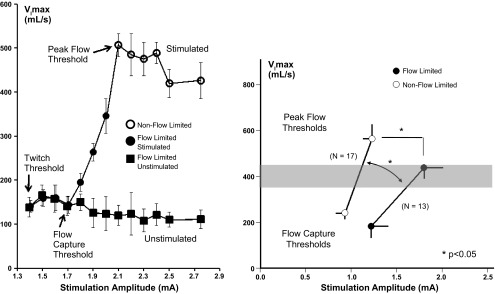Fig. 4.

Left: maximal inspiratory airflow (VImax) responses to increasing levels of stimulation current (mA, milliamperes) on every other inspiration demonstrates progressive increases in inspiratory flow and the elimination of inspiratory flow limitation without arousing the patient from sleep. The findings imply that responses can be optimized by titrating stimulation intensity to maximize VImax (pharyngeal patency) during sleep. (37). Right: maximal inspiratory airflow (VImax) vs. stimulation current (milliamperes) in groups with (solid circles) and without (open circles) inspiratory flow limitation at the peak flow threshold. The flow response slope in the non-flow-limited group was greater than that in the flow-limited subgroup (1,241 ± 199 vs. 674 ± 167 ml·s−1·mA−1; n = 25; P < 0.05). Lower levels of stimulation current were required to achieve peak airflow in the non-flow-limited compared with flow-limited subgroup (1.23 ± 0.10 vs. 1.80 ± 0.20 mA; n = 25; P < 0.05), although peak inspiratory airflow did not differ between non-flow-limited and flow-limited subgroups (564 ± 58 vs. 438 ± 35 ml/s). Both groups attained normal or near-normal levels during sleep of ∼400 ml/s or greater (shaded region). (37).
